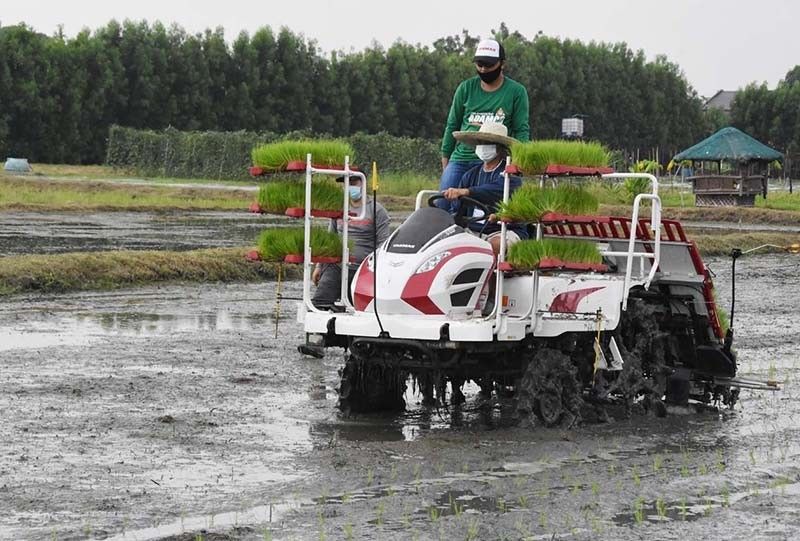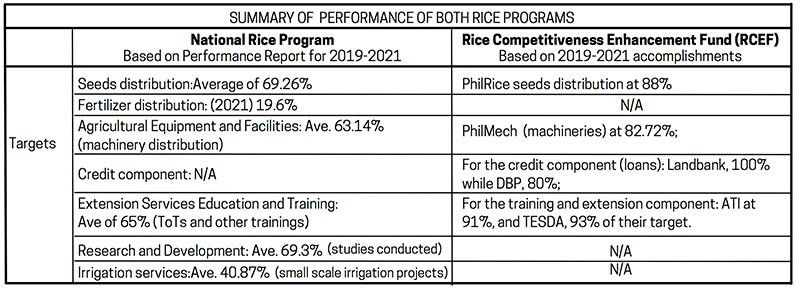National Rice Program underperformed, Rice Competitiveness Enhancement Fund delivered

MANILA, Philippines — The Rice Competitiveness Enhancement Fund (RCEF) is allocated with a P10B budget coming from the tariff collection from imported rice, as provided for by Republic Act 11203 or the Rice Tariffication Law (RTL).
A key feature of the law is the Rice Competitiveness Enhancement Fund, or RCEF, which is a guaranteed annual allocation of P10 Billion that began since the implementation of the law in 2019, and would last until 2024. It is allocated and disbursed as follows:
- Rice farm machinery and equipment (50%) or P5B per year, released to and implemented by the Philippine Center for Postharvest Development and Mechanization (PhilMech)
- Rice seed development, propagation and promotion (30%) or P3B per year, released to and implemented by the Philippine Rice Research Institute (PhilRice)
- Expanded rice credit assistance (10%) or P1B per year, made available in the form of credit facility with minimal interest rates and minimum collateral requirements to rice farmers and cooperatives to be managed equally by the Land Bank of the Philippines (LBP) and the Development Bank of the Philippines (DBP)
- Rice extension services (10%) or P1B per year, made available for extension services provided by the PhilMech, PhilRice, Agricultural Training Institute (ATI), and Technical Education and Skills Development Authority (TESDA).
Republic Act No. 11589 or the Cash Assistance for Filipino Farmers Act was signed by President Duterte on December 10, 2021, allowing the grant of financial assistance of P5,000 to 1.6 million farmers who are farming 2 hectares and below until 2024, from the excess of the P10B tariff collected from imported rice.
Issues have been unfairly raised to discredit what has been accomplished by the RTL. Questions on the effectiveness of the program and performance monitoring are allegations without sufficient basis.
To begin with, at least two million farmers are now reaping the benefits under the RCEF. The RCEF has been properly utilized and component deliverables have been effectively achieved despite the ongoing pandemic. Monitoring and reporting have been very transparent.
Suffice it to say, it should serve as a model for the other rice program, the National Rice Program (NRP), as well as other banner agricultural programs.
- Rice yield continued to improve as the harvest in 2021 reached 19.95 MMT, despite the P2.5 Billion damage wrecked by Typhoon Odette as reported by the Department of Agriculture. In 2020, the harvest also improved by 3.3% at 19.4 MMT, which is more than the 18.81 MMT output in 2019
- Production cost has been reduced for those who availed of rice production machinery
- Post-harvest losses have been reduced in post-production (harvesting, threshing, drying and milling) for those who availed of the services
- Increase in value-adding income from rice and non-rice sources
Notwithstanding the pandemic and the occasional acidic comments of critics, the different components of RCEF have achieved their targets from 2019-2021 as follows:
- PhilRice seeds distribution at 88%; PhilMech, (machinery) at 82.72%
- For the credit component (loans): Landbank, 100% while DBP, 80%
- For the training and extension component: ATI at 91%, and TESDA, 93% of their target.
We can only commend these agencies for their accomplishment despite the difficulty of the pandemic.
Originally, the RCEF-Seed covers 57 provinces, which are selected based on yield, area harvested, cost of production and percentage of irrigated area. The program operates in cities and municipalities within these provinces with at least 100 hectares of rice area.
Starting 2021 wet season, the program is focusing on 42 provinces with low to medium yield and limited certified seed adoption to create greater impact.
Taking everything into account, the Rice Tariffication Law led to a significant drop in inflation because the price of rice in the market became stable.
While food prices steadily rose by around 1.6% year on year, the price of rice went down to 0.1% inflation in 2021 according to NEDA. Rice is no longer a contributory factor to inflation.
The National Rice Program
The National Rice Program has a budget of P15.7B for 2022 under the Office of the Secretary to be spent on the following:
- P6.39B – Procurement of hybrid seeds
- P4.49B – Chemical fertilizer
- P933M– Irrigation services, which has been similarly provided for in the NIA budget of P31B
- P1.357B – Extension Support Education and Training. The same item has an allocation of P1B in the RCEF
- P632M – Research and Development
- P1.96B – Equipment and Facilities. Allocation for equipment was also provided for in the RCEF
Items already receiving allocation from other programs should not be duplicated by National Rice Program. Duplication creates an issue of who is accountable and which fund was used. It is also a counterintuitive measure and promotes inefficient use of resources.
Yet, the promotion of hybrid rice has been the central goal of the National Rice Program since 2001. The adoption rate of hybrids by farmers has remained low (about 5% of total rice area) despite concerted efforts and massive subsidies.
Evidently, most rice farmers do not find the currently available hybrid rice varieties to be economically superior to inbred varieties. At farmers’ level, their yield advantage has not compensated for the higher cost of seeds, labor and other inputs usually required by hybrid varieties.
Unlike inbred varieties which can be grown by farmers, hybrid varieties need to be purchased every cropping season. While some hybrid varieties may be suited to irrigated areas with developed market infrastructure, demand by farmers has not been sufficiently large and concentrated for private seed companies to be commercially viable.
The highly subsidized approach of the program has been not just ineffective but costly in terms of wasting scarce budgetary resources, compromising the government’s regulatory functions, promoting corruption, and distorting farmers’ varietal choices.
With this, the NRP, which has been in existence since 1986, failed to address the important issues that plagued the rice industry. Almost 36 years since its inception, significant policy reforms were still needed to make our rice farmers more competitive.
In terms of budget, the NRP under the DA-OSEC was undoubtedly given a full arm of resources to capitalize on. In 2019, P675M from allocation of NRP’s P7.4 Billion budget went to seeds distribution only. There was no allocation for fertilizer.
In 2020, its budget rose to P19,528,218,000 owing to additional funds coming from the Bayanihan Acts. Of the said amount, P7,193,611,000 went to seeds distribution or 36.8% and P8,313,745,000 for fertilizer distribution or 42.5% of the whole budget.
In 2020, as mandated, National Rice Program began distributing seeds and fertilizers to farmers. But by 2021, it began distributing vouchers worth P2,100 for hybrid and P1,200 for inbred in lieu of fertilizer valued at P2,500/bag (it was previously valued at P1,000/bag in 2020). This was without regard to the total farmland area of the beneficiaries.
Per the accomplishment report, 418,684 farmers benefitted from this distribution. If for argument's sake, we multiply that with the value of fertilizer for hybrid seeds in order to arrive at the total value of vouchers given away, we only get P879,236,400.
However, the budget allocated for fertilizer distribution for 2021 is at P4,404,391,000. This comes as a shock as it means that National Rice Program was only able to utilize 19.6% of the total budget allocated for fertilizer in 2021.
There seems to be no sense of urgency for this program. The allocation was given in order for the government to immediately respond to the needs of the farmers in this time of crisis.
The performance of both rice programs can be summed up as follows:

Based on the foregoing, the effectiveness of the rice programs has been measured vis-à-vis their purposes/objectives and the efficiency in utilization of their budget.
Clearly, according to those metrics, the National Rice Program underperformed, while the Rice Competitiveness Enhancement Fund (RCEF) delivered.
- Latest






























